Historically Based Room Acoustic Analysis and Auralization of a Church in the 1470s
Abstract
1. Introduction
“those sites, objects and intangible things that have cultural, historical, aesthetic, archaeological, scientific, ethnological or anthropological value to groups and individuals” [1].
2. Background on the Church
3. Digital and Historical Reconstruction
3.1. Model Creation
3.1.1. The Nave Area
3.1.2. The Nuns’ Gallery
3.1.3. The Monks’ Choir
3.2. Recording Liturgy
Recordings
3.3. Room Acoustic Simulations
3.3.1. Adaptation of the Digital Model
3.3.2. Acoustic Properties of Materials in the Church and Calibration of the Model
3.3.3. Listener and Source Positions
4. Room Acoustic Analysis
4.1. Acoustics within the Choir and Gallery
4.2. Acoustics in the Nave
5. Discussion
6. Conclusions
Supplementary Materials
Author Contributions
Funding
Institutional Review Board Statement
Informed Consent Statement
Data Availability Statement
Acknowledgments
Conflicts of Interest
Appendix A. Material Parameters for Acoustic Simulation
| Material | Absorption Factor | Mid-Frequency Scattering | |||||||
|---|---|---|---|---|---|---|---|---|---|
| 63 Hz | 125 Hz | 250 Hz | 500 Hz | 1000 Hz | 2000 Hz | 4000 Hz | 8000 Hz | ||
| Thin silk textile, freely suspended 1 | 0.05 | 0.05 | 0.06 | 0.39 | 0.63 | 0.70 | 0.73 | 0.73 | 0.01 |
| Wool textile 1 | 0.07 | 0.07 | 0.31 | 0.49 | 0.75 | 0.70 | 0.60 | 0.60 | 0.01 |
| Thick wool (carpet) 1 | 0.02 | 0.02 | 0.06 | 0.14 | 0.37 | 0.60 | 0.65 | 0.65 | 0.01 |
| Heavy velvet 1 | 0.03 | 0.03 | 0.03 | 0.15 | 0.4 | 0.50 | 0.50 | 0.50 | 0.01 |
| Thick linen against stone 1 | 0.01 | 0.01 | 0.02 | 0.05 | 0.15 | 0.30 | 0.40 | 0.40 | 0.01 |
| Wooden construction, not painted 2 | 0.09 | 0.09 | 0.09 | 0.08 | 0.08 | 0.10 | 0.07 | 0.07 | 0.60 |
| Wooden construction, painted 2 | 0.11 | 0.11 | 0.11 | 0.10 | 0.10 | 0.10 | 0.07 | 0.07 | 0.40 |
| Wooden decoration, painted 2,3 | 0.12 | 0.12 | 0.12 | 0.15 | 0.15 | 0.18 | 0.18 | 0.19 | 0.99 |
| Hollow wooden structure, painted 1 | 0.40 | 0.40 | 0.30 | 0.20 | 0.17 | 0.15 | 0.10 | 0.10 | 0.60 |
| Plastered brick 6 | 0.102 | 0.029 | 0.144 | 0.097 | 0.007 | 0.016 | 0.008 | 0.003 | 0.20 |
| Limestone 6 | 0.028 | 0.074 | 0.005 | 0.034 | 0.09 | 0.028 | 0.084 | 0.009 | 0.003 |
| Plastered limestone 4 | 0.07 | 0.06 | 0.05 | 0.05 | 0.04 | 0.04 | 0.04 | 0.04 | 0.001 |
| Ceiling vaults 5 | 0.12 | 0.09 | 0.09 | 0.05 | 0.04 | 0.03 | 0.03 | 0.03 | 0.30 |
| Leaded glass windows 6 | 0.254 | 0.259 | 0.24 | 0.016 | 0.101 | 0.039 | 0.495 | 0.003 | 0.14 |
| Iron lattice 5 | 0.01 | 0.01 | 0.01 | 0.02 | 0.06 | 0.03 | 0.03 | 0.03 | 0.001 |
| People 1 | 0.62 | 0.62 | 0.72 | 0.80 | 0.83 | 0.84 | 0.85 | 0.85 | |
References
- UNESCO. Concept of Digital Heritage; UNESCO: London, UK, 2019.
- UNESCO. Convention for the Safeguarding of the Intangible Cultural Heritage; UNESCO: London, UK, 2003.
- Lubman, D.; Kiser, B.H. The History of Western Civilization Told through the Acoustics of its Worship Spaces. In Proceedings of the 17th International Congress on Acoustics, Rome, Italy, 2–7 September 2001. [Google Scholar]
- Martellotta, F. Optimal Reverberation Conditions in Churches. In Proceedings of the International Congress on Acoustics 2007, Madrid, Spain, 2–7 September 2007; Sociedad Espanola de Acustica: Madrid, Spain, 2007. [Google Scholar]
- Howard, D. Recordings of Music Written for St. Mark’s. In Word, Image, and Song: Essays on Early Modern Italy; University of Rochester Press: Rochester, NY, USA, 2013; Volume 1, pp. 89–100. [Google Scholar]
- Navarro, J.; Sendra, J.J.; Muñoz, S. The Western Latin church as a place for music and preaching: An acoustic assessment. Appl. Acoust. 2009, 70, 781–789. [Google Scholar] [CrossRef]
- Pedrero, A.; Ruiz, R.; Díaz-Chyla, A.; Díaz, C. Acoustical study of Toledo Cathedral according to its liturgical uses. Appl. Acoust. 2014, 85, 23–33. [Google Scholar] [CrossRef]
- Aletta, F.; Kang, J. Historical Acoustics: Relationships between People and Sound over Time. Acoustics 2020, 2, 9. [Google Scholar] [CrossRef]
- Đorđević, Z.; Novković, D.; Andrić, U. Archaeoacoustic Examination of Lazarica Church. Acoustics 2019, 1, 24. [Google Scholar] [CrossRef]
- Elicio, L.; Martellotta, F. Acoustics as a cultural heritage: The case of Orthodox churches and of the “Russian church” in Bari. J. Cult. Herit. 2015, 16, 912–917. [Google Scholar] [CrossRef]
- Girón, S.; Álvarez-Morales, L.; Zamarreño, T. Church acoustics: A state-of-the-art review after several decades of research. J. Sound Vib. 2017, 411, 378–408. [Google Scholar] [CrossRef]
- Kosała, K. Calculation Models for Acoustic Analysis of St. Elizabeth of Hungary Church in Jaworzno Szczakowa. Arch. Acoust. 2016, 41, 485–498. [Google Scholar] [CrossRef]
- Niemas, M.; Sadowski, J.; Engel, Z. Acoustic Issues of Sacral Structures. Arch. Acoust. 1998, 23, 87–104. [Google Scholar]
- Kanev, N. Resonant Vessels in Russian Churches and Their Study in a Concert Hall. Acoustics 2020, 2, 23. [Google Scholar] [CrossRef]
- Swedish Research Council. The Multisensory World of Vadstena Abbey in the Late Middle Ages. 2016. Available online: https://www.swecris.se/betasearch/details/project/201601784VR?lang=en (accessed on 11 January 2021).
- Scarre, C.; Lawson, G. Archaeoacoustics; McDonald Institute for Archaeological Research: Cambridge, UK, 2006. [Google Scholar]
- Boren, B.; Longair, M. A Method for Acoustic Modeling of Past Soundscapes. In Proceedings of the Acoustics of Ancient Theatres Conference, Patras, Greece, 18–21 September 2011; European Acoustics Association and the Hellenic Institute of Acoustics: Patras, Greece, 2011. [Google Scholar]
- Berardi, U.; Iannace, G.; Maffei, L. Virtual reconstruction of the historical acoustics of the Odeon of Pompeii. J. Cult. Herit. 2016. [Google Scholar] [CrossRef]
- Martellotta, F.; Álvarez-Morales, L. Virtual acoustic reconstruction of the church of Gesú in Rome: A comparison between different design options. In Proceedings of the Forum Acusticum 2014, Krakow, Poland, 7–12 September 2014; The Polish Acoustical Society: Krakow, Poland, 2014. [Google Scholar] [CrossRef]
- Alonso, A.; Sendra, J.J.; Suárez, R.; Zamarreño, T. Acoustic evaluation of the cathedral of Seville as a concert hall and proposals for improving the acoustic quality perceived by listeners. J. Build. Perform. Simul. 2014, 7, 360–378. [Google Scholar] [CrossRef]
- Sender, M.; Planells, A.; Perelló, R.; Segura, J.; Giménez, A. Virtual acoustic reconstruction of a lost church: Application to an Order of Saint Jerome monastery in Alzira, Spain. J. Build. Perform. Simul. 2018, 11, 369–390. [Google Scholar] [CrossRef]
- Selfridge, R.; Cook, J.; McAlpine, K.; Newton, M. Creating Historic Spaces in Virtual Reality using off-the-shelf Audio Plugins. In Proceedings of the 2019 AES International Conference on Immersive and Interactive Audio, York, UK, 27–29 March 2019; Audio Engineering Society: York, UK, 2019. [Google Scholar]
- Postma, B.N.J.; Katz, B.F.G. Perceptive and objective evaluation of calibrated room acoustic simulation auralizations. J. Acoust. Soc. Am. 2016, 140, 4326–4337. [Google Scholar] [CrossRef]
- Katz, B.F.G.; Poirier-quinot, D.; Postma, B.N.J. Virtual reconstructions of the Théâtre de l ’ Athénée for archeoacoustic study. In Proceedings of the 23rd International Congress on Acoustics integrating 4th EAA Euroregio 2019, Aachen, Germany, 9–13 September 2019; Deutsche Gesellschaft für Akustik: Aachen, Germany, 2019; pp. 303–310. [Google Scholar]
- Kleiner, M.; Dalenbäck, B.I.; Svensson, P. Auralization—An Overview. J. Audio Eng. Soc. 1993, 41, 861–875. [Google Scholar]
- Mehra, R.; Rungta, A.; Golas, A.; Lin, M.; Manocha, D. WAVE: Interactive Wave-based Sound Propagation for Virtual Environments. IEEE Trans. Vis. Comput. Graph. 2015, 21, 434–442. [Google Scholar] [CrossRef] [PubMed]
- Pelzer, S.; Aspöck, L.; Schröder, D.; Vorländer, M. Interactive Real-Time Simulation and Auralization for Modifiable Rooms. Build. Acoust. 2014, 21. [Google Scholar] [CrossRef]
- Poirier-Quinot, D.; Katz, B.; Noisternig, M. EVERTims: Open source framework for real-time auralization in VR. In Proceedings of the AM ’17, London, UK, 23–26 August 2017; ACM: New York, NY, USA; London, UK, 2017. [Google Scholar]
- Vorländer, M. Auralization. Fundamentals of Acoustics, Modelling, Simulation, Algorithms and Acoustic Virtual Reality, 1st ed.; Springer: Berlin, Germany, 2008; pp. 1–335. [Google Scholar] [CrossRef]
- Anderson, J.S.; Bratos-Anderson, M. Acoustic coupling effects in St Paul’s Cathedral, London. J. Sound Vib. 2000, 236, 209–225. [Google Scholar] [CrossRef]
- Álvarez-Morales, L.; Lopez, M.; Alvarez-Corbacho, A.; Bustamante, P. Mapping the acoustics of Ripon cathedral. In Proceedings of the 23rd International Congress on Acoustics, Aachen, Germany, 9–13 September 2019; Deutsche Gesellschaft für Akustik: Aachen, Germany, 2019. [Google Scholar]
- Boren, B.; Longair, M.; Orlowski, R. Acoustic Simulation of Renaissance Venetian Churches. Acoust. Pract. 2013, 1, 17–28. [Google Scholar] [CrossRef]
- Alonso, A.; Suárez, R.; Sendra, J. The Acoustics of the Choir in Spanish Cathedrals. Acoustics 2018, 1, 4. [Google Scholar] [CrossRef]
- Martellotta, F. Subjective study of preferred listening conditions in Italian Catholic churches. J. Sound Vib. 2008, 317, 378–399. [Google Scholar] [CrossRef]
- Martellotta, F. Identifying acoustical coupling by measurements and prediction-models for St. Peter’s Basilica in Rome. J. Acoust. Soc. Am. 2009, 126, 1175–1186. [Google Scholar] [CrossRef] [PubMed]
- Andersson, I.; Ljungstedt, S.; Malm, G. Vadstena Klosterkyrka. 1, Kyrkobyggnaden; Riksantikvarieämbetet och Kungl. Vitterhets-, Historie-, och Antikvitetsakademien: Borås, Sweden, 1991. [Google Scholar]
- Strinnholm Lagergren, K. The invitatory antiphons in Cantus sororum: A unique repertoire in a world of standard chant. Plainsong Mediev. Music. 2018, 27, 121–142. [Google Scholar] [CrossRef]
- Berthelson, B. Studier i Birgittinerordens Byggnadsskick 1, Anläggningsplanen och dess Tillämpning; Kungl. Vitterhets-, historie- och antikvitetsakademien: Stockholm, Sweden, 1947. [Google Scholar]
- Andersson, A. Vadstena Klosterkyrka II. Inredning; Riksantikvarieämbetet och Kungl. Vitterhets-, historie- och antikvitetsakademien: Borås, Sweden, 1983. [Google Scholar]
- Sigurdson, J.M.; Zachrisson, S. Aplagårdar och Klosterliljor: 800 år kring Vadstena Klosters Historia; Artos: Skellefteå, Sweden, 2010. [Google Scholar]
- Nyberg, T.S. Birgittinische Klostergründungen des Mittelalters; Gleerup: Lund, Sweden, 1965. [Google Scholar]
- Bennett, R. Vadstena klosterkyrka III. Gravminnen; Riksantikvarieämbetet och Kungl. Vitterhets-, Historie-, och Antikvitetsakademien: Borås, Sweden, 1985. [Google Scholar]
- Autio, H.; Bard, D. A statistical method for parameter estimation from Schroeder decay curves. In Proceedings of the INTER-NOISE 2018, The 47th International Congress and Exposition on Noise Control Engineering, Chicago, IL, USA, 26–29 August 2018; INCE-USA: Chicago, IL, USA, 2018. [Google Scholar]
- Alonso, A.; Sendra, J.J.; Suárez, R. Sound Space Reconstruction in the Cathedral of Seville for major feasts celebrated around the main chancel. In Proceedings of the Forum Acusticum 2014, Krakow, Poland, 7–12 September 2014; The Polish Acoustical Society: Krakow, Poland, 2014. [Google Scholar]
- Sancta Birgitta. Reuelaciones Extrauagantes; Almqvist & Wiksell: Stockholm, Sweden, 1956. [Google Scholar]
- Klemming, G.E. (Ed.) Lucidarium. In Heliga Birgittas Uppenbarelser; P. A. Nordstedt & Söner: Stockholm, Sweden, 1884; Volume 5. [Google Scholar]
- Ugglas, C.R.A. En svensk korsväg med målade stationsbilder, del 1. Fornvännen 1938, 33, 230–272. [Google Scholar]
- Sancta Birgitta. Opera Minora, Vol 1: Regula Saluatorie; Almqvist & Wiksell: Stockholm, Sweden, 1975. [Google Scholar]
- Boren, B.; Abraham, D.; Naressi, R.; Grzyb, E.; Lane, B.; Merceruio, D. Acoustic Simulation of Bach’s Performing Forces in the Thomaskirche. In Proceedings of the 1st EAA Spatial Audio Signal Processing Symposium, Paris, France, 6–7 September 2019; Sorbonne Université: Paris, France, 2019. [Google Scholar]
- ODEON Room Acoustics Software. 2020. Available online: https://www.geonoise.com/odeon-room-acoustics-software/ (accessed on 26 December 2020).
- Postma, B.N.J.; Katz, B.F.G. Creation and calibration method of acoustical models for historic virtual reality auralizations. Virtual Real. 2015, 19, 161–180. [Google Scholar] [CrossRef]
- ISO 3382-1:2009. Acoustics—Measurement of Room Acoustic Parameters—Part 1: Performance Spaces; Technical Report; ISO: Geneva, Switzerland, 2009. [Google Scholar]
- Pilch, A. Optimization-based method for the calibration of geometrical acoustic models. Appl. Acoust. 2020, 170. [Google Scholar] [CrossRef]
- Vorländer, M. Computer simulations in room acoustics: Concepts and uncertainties. J. Acoust. Soc. Am. 2013, 133, 1203–1213. [Google Scholar] [CrossRef]
- Suárez, R.; Alonso, A.; Sendra, J.J. Archaeoacoustics of intangible cultural heritage: The sound of the Maior Ecclesia of Cluny. J. Cult. Herit. 2016, 19, 567–572. [Google Scholar] [CrossRef]
- Alonso, A.; Suárez, R.; Sendra, J.J. Virtual reconstruction of indoor acoustics in cathedrals: The case of the Cathedral of Granada. Build. Simul. 2017, 10, 431–446. [Google Scholar] [CrossRef]
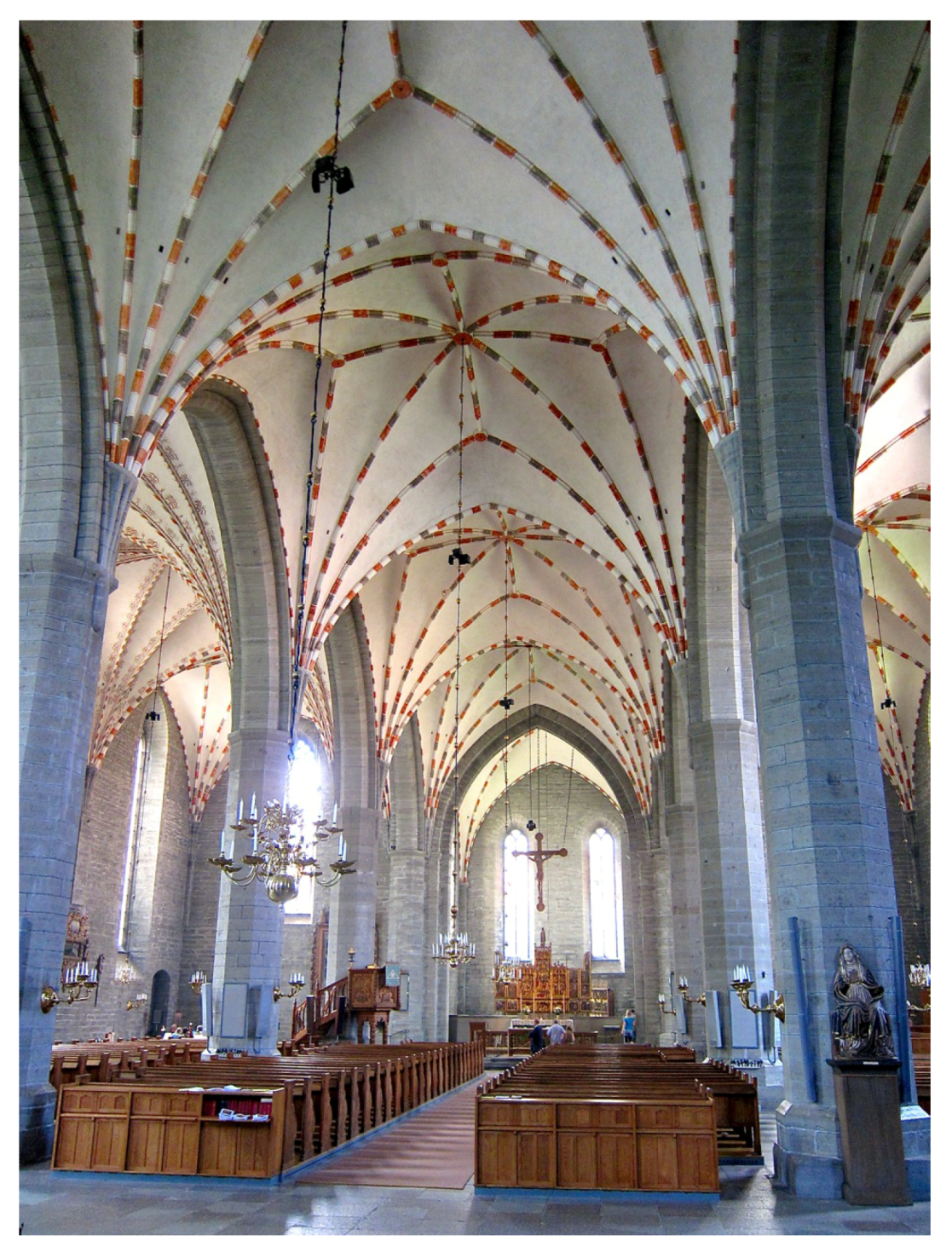
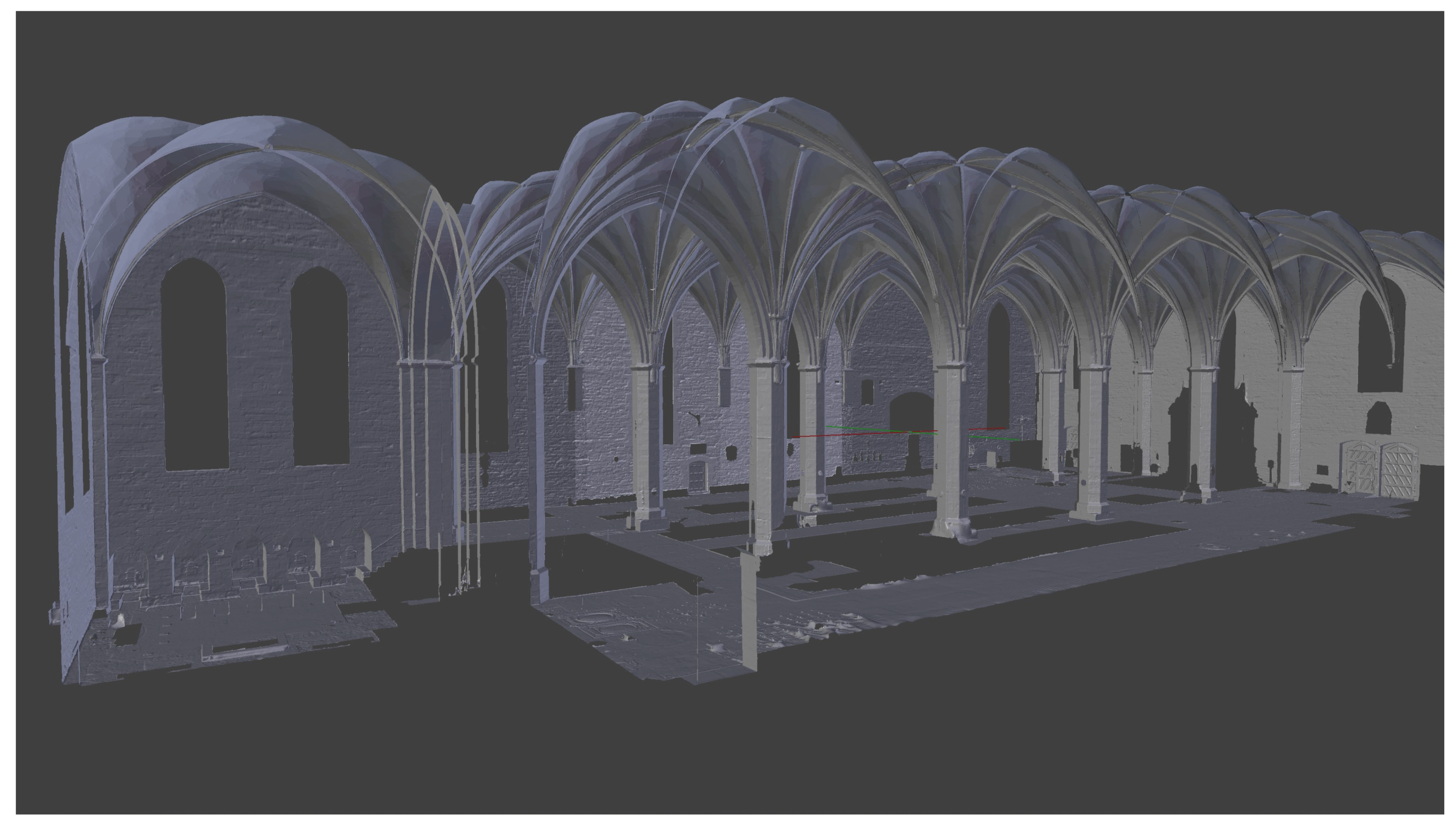
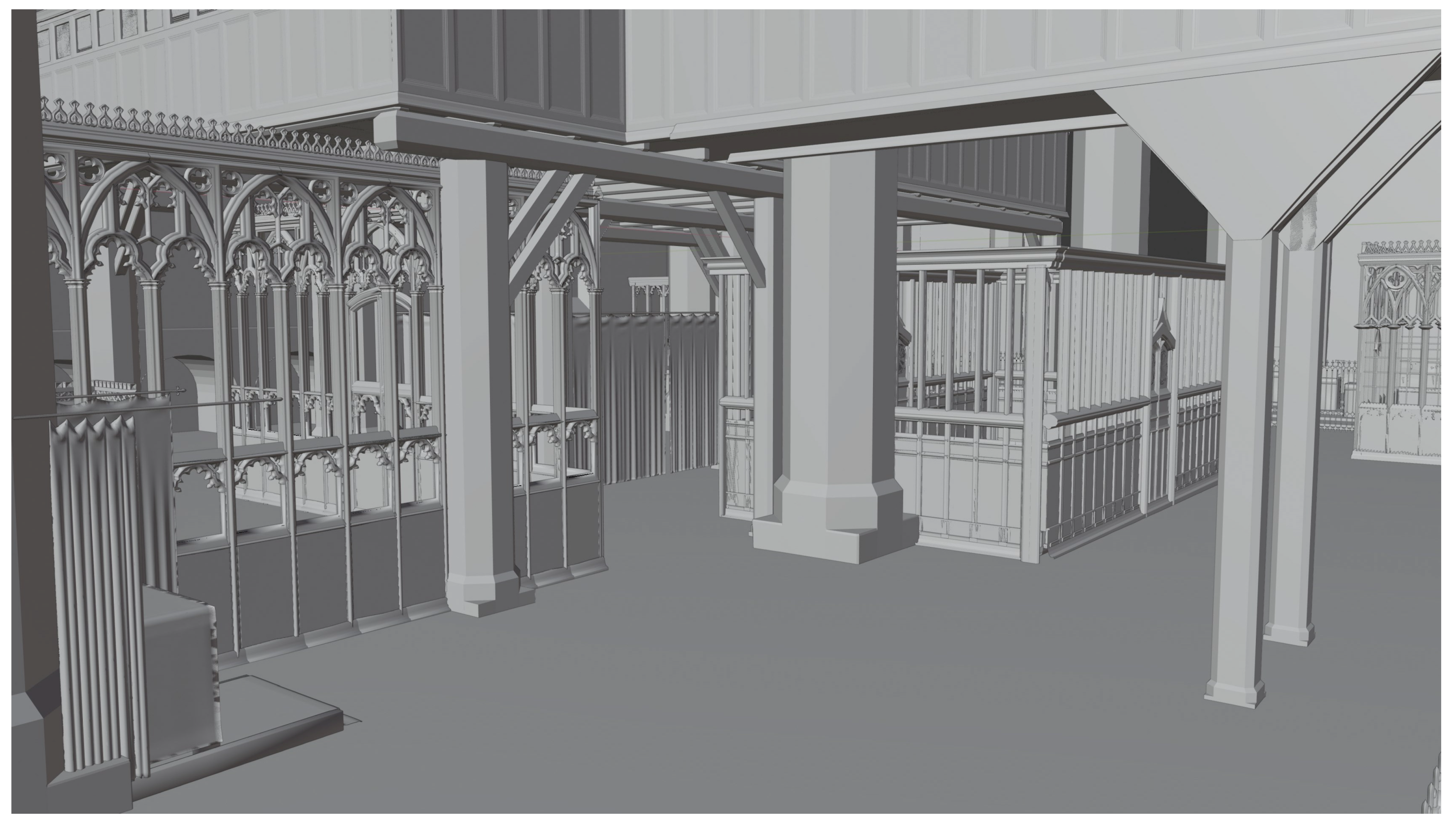
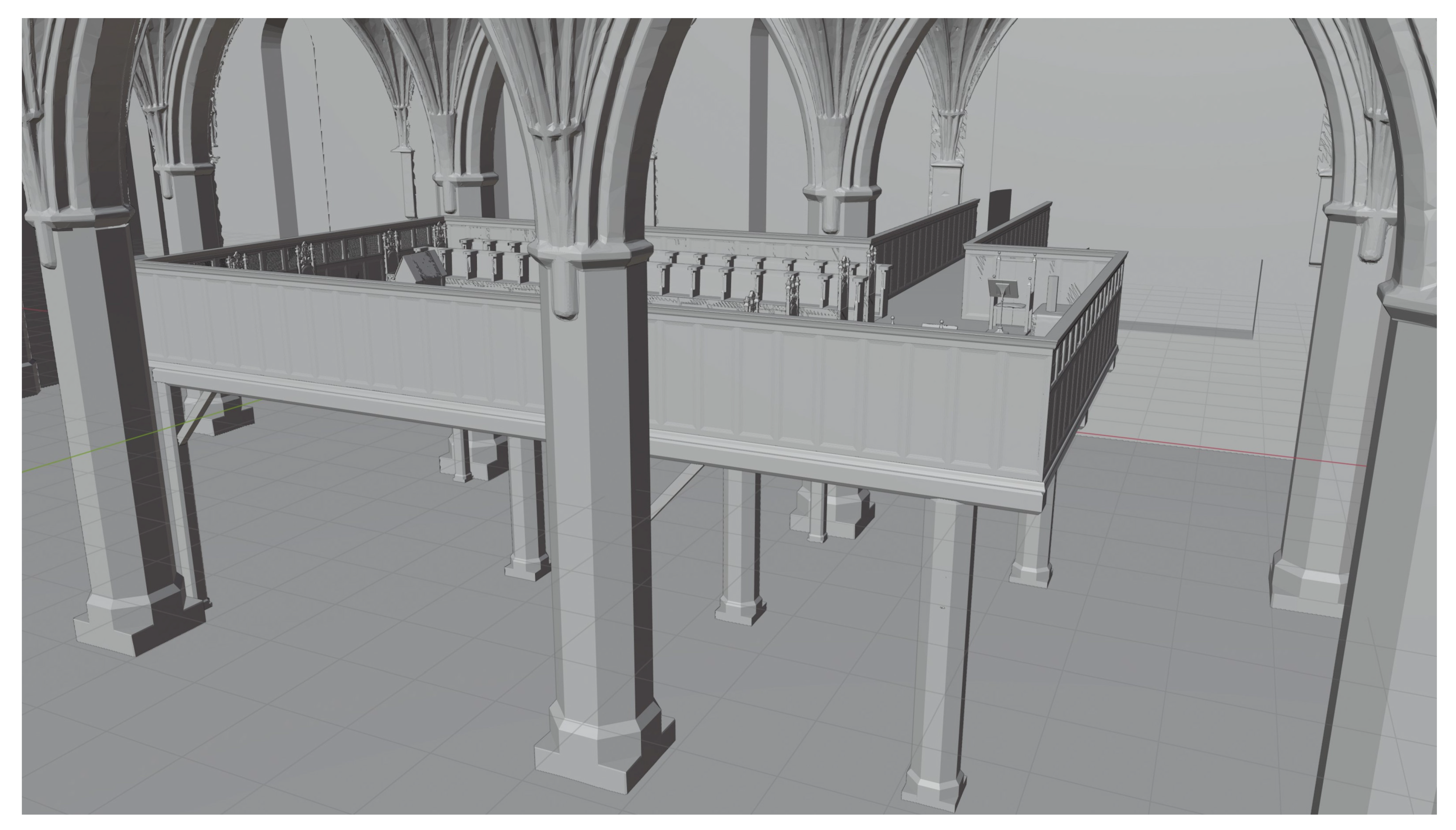
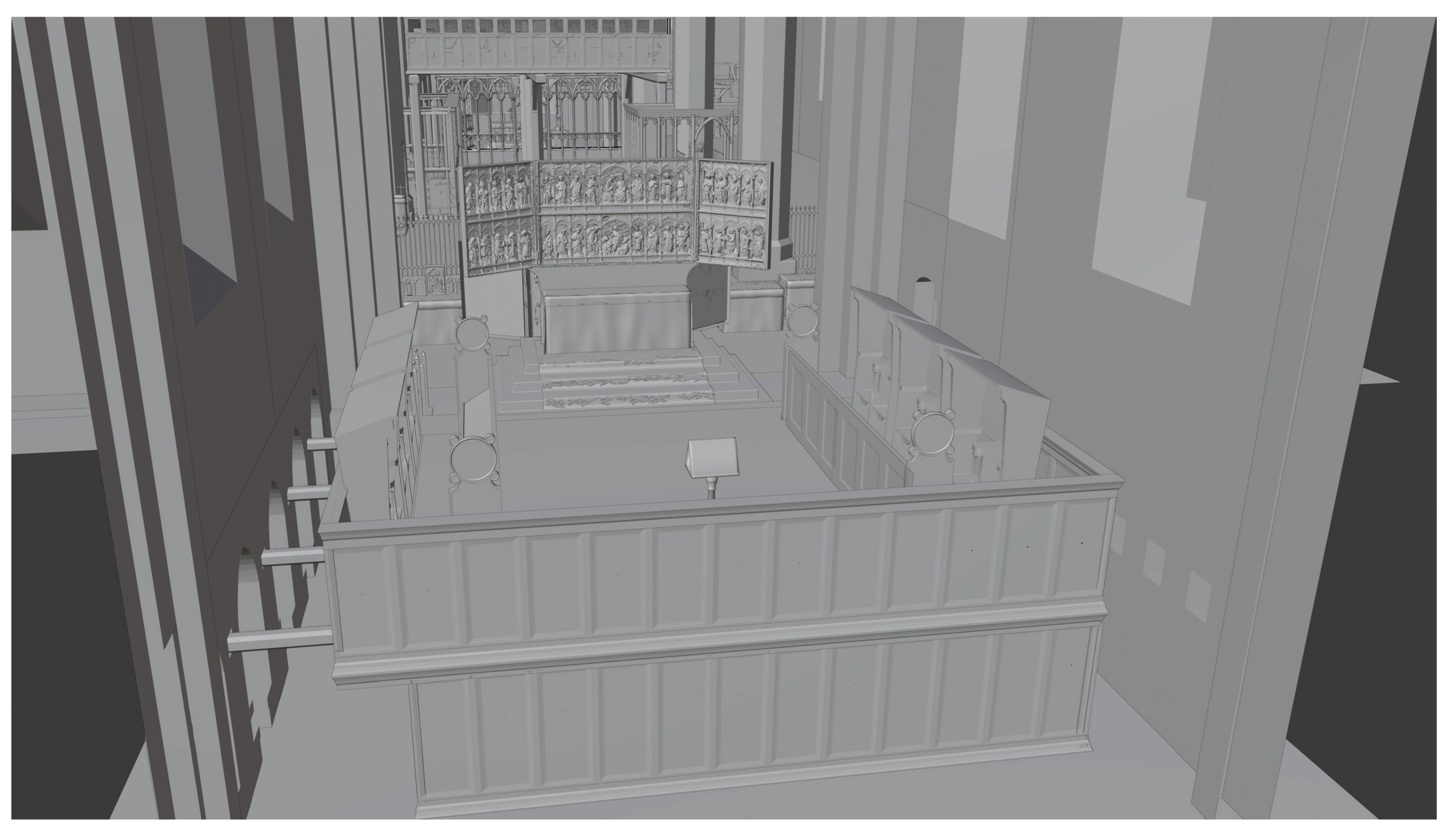
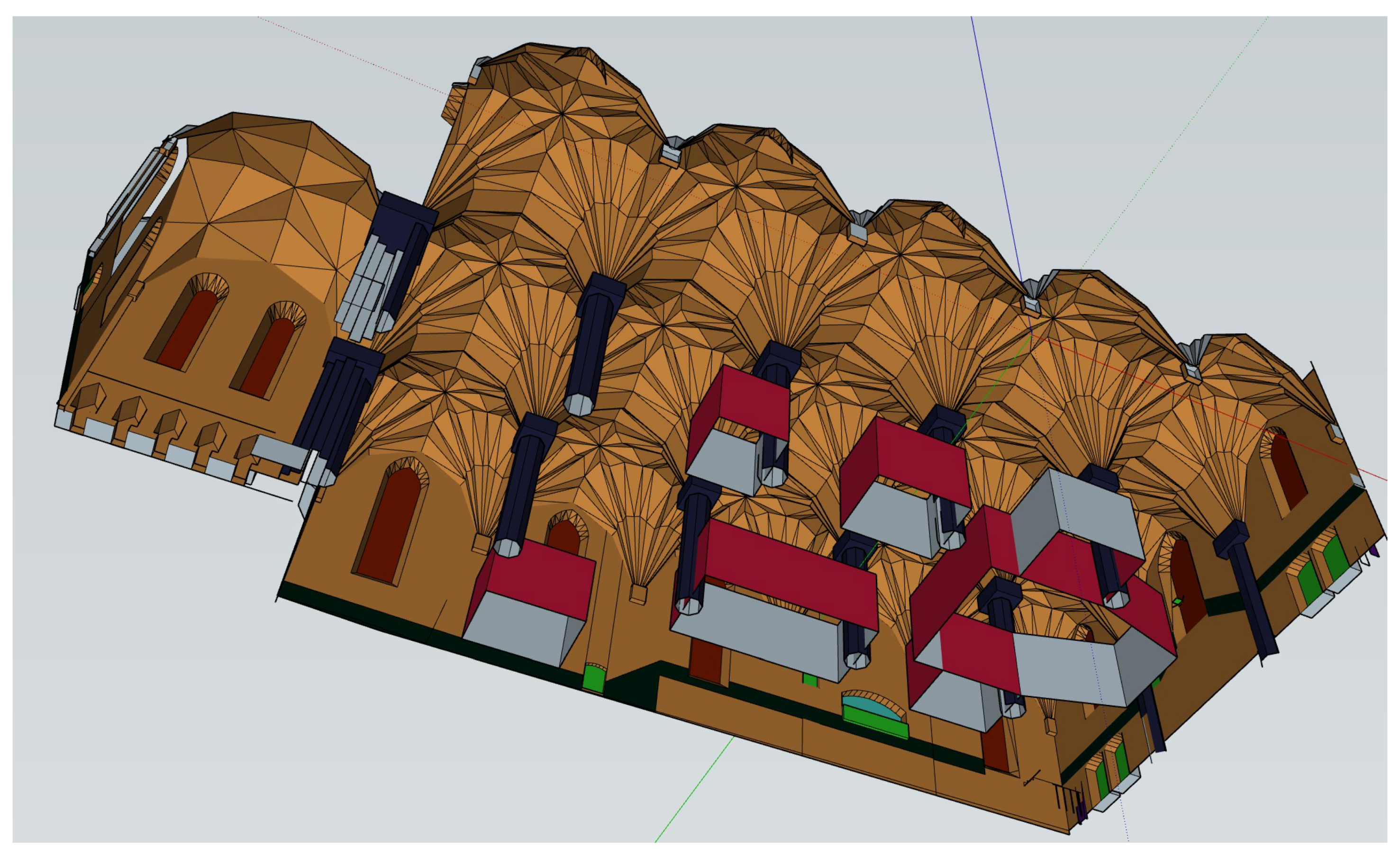
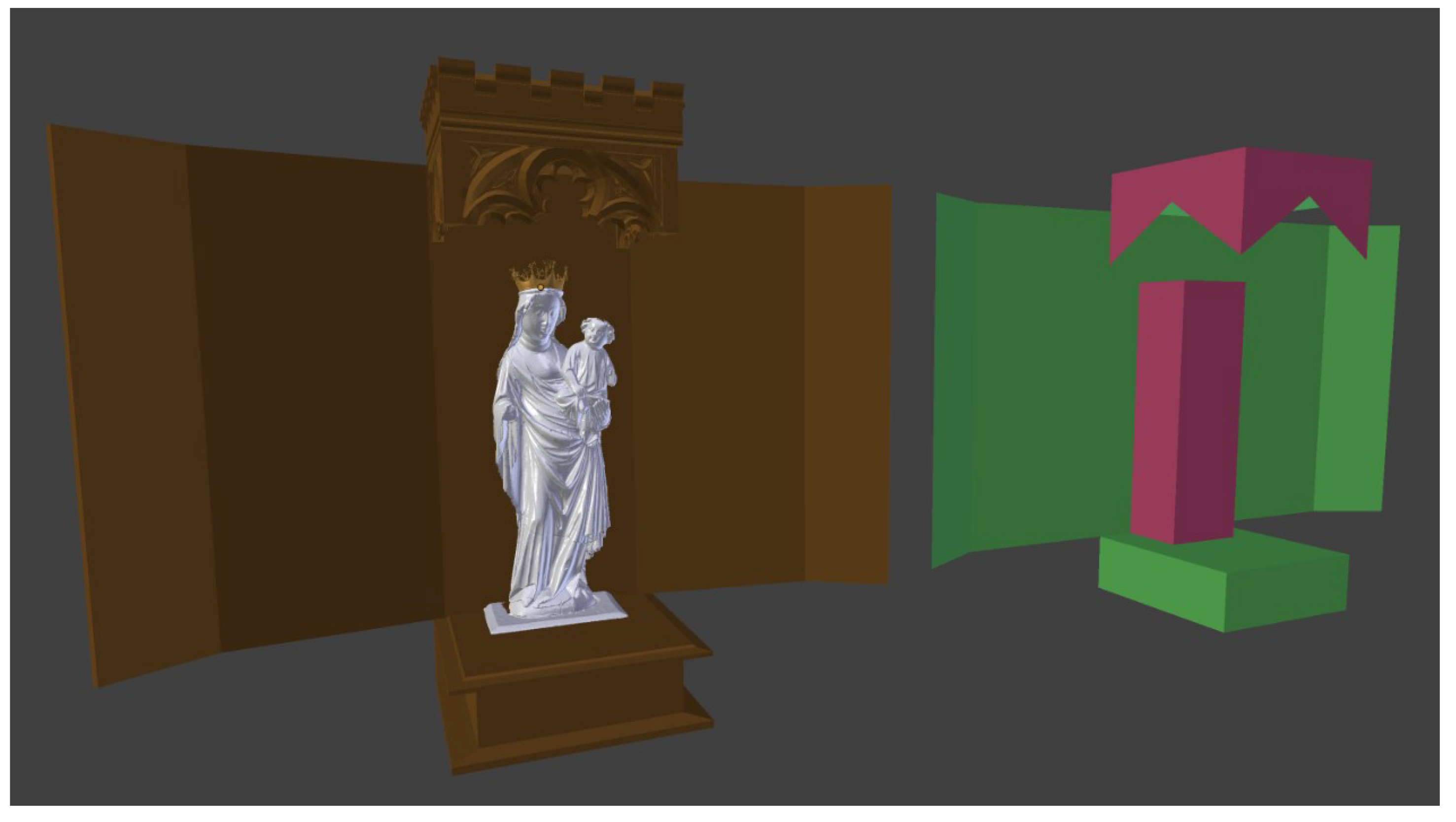
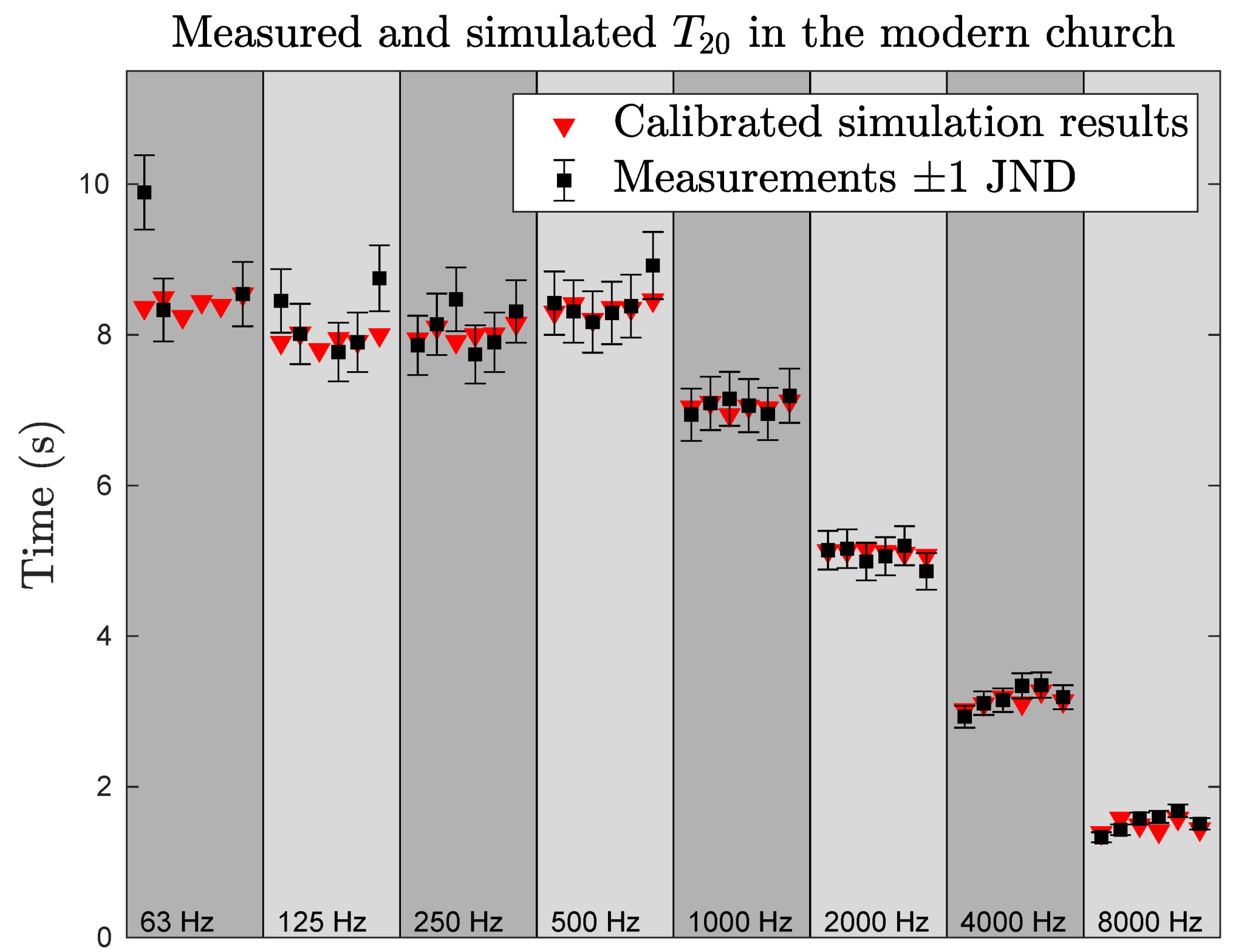
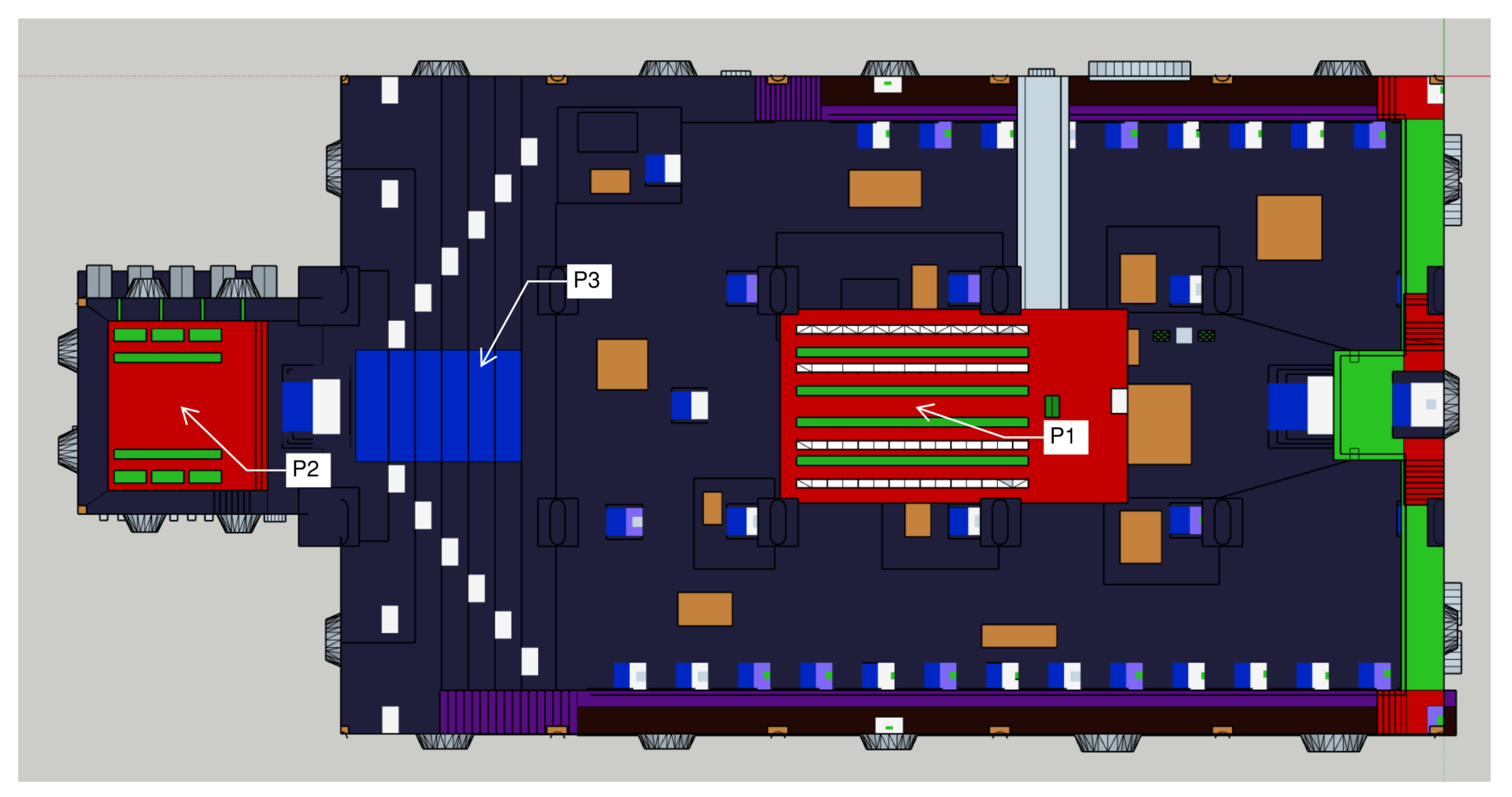
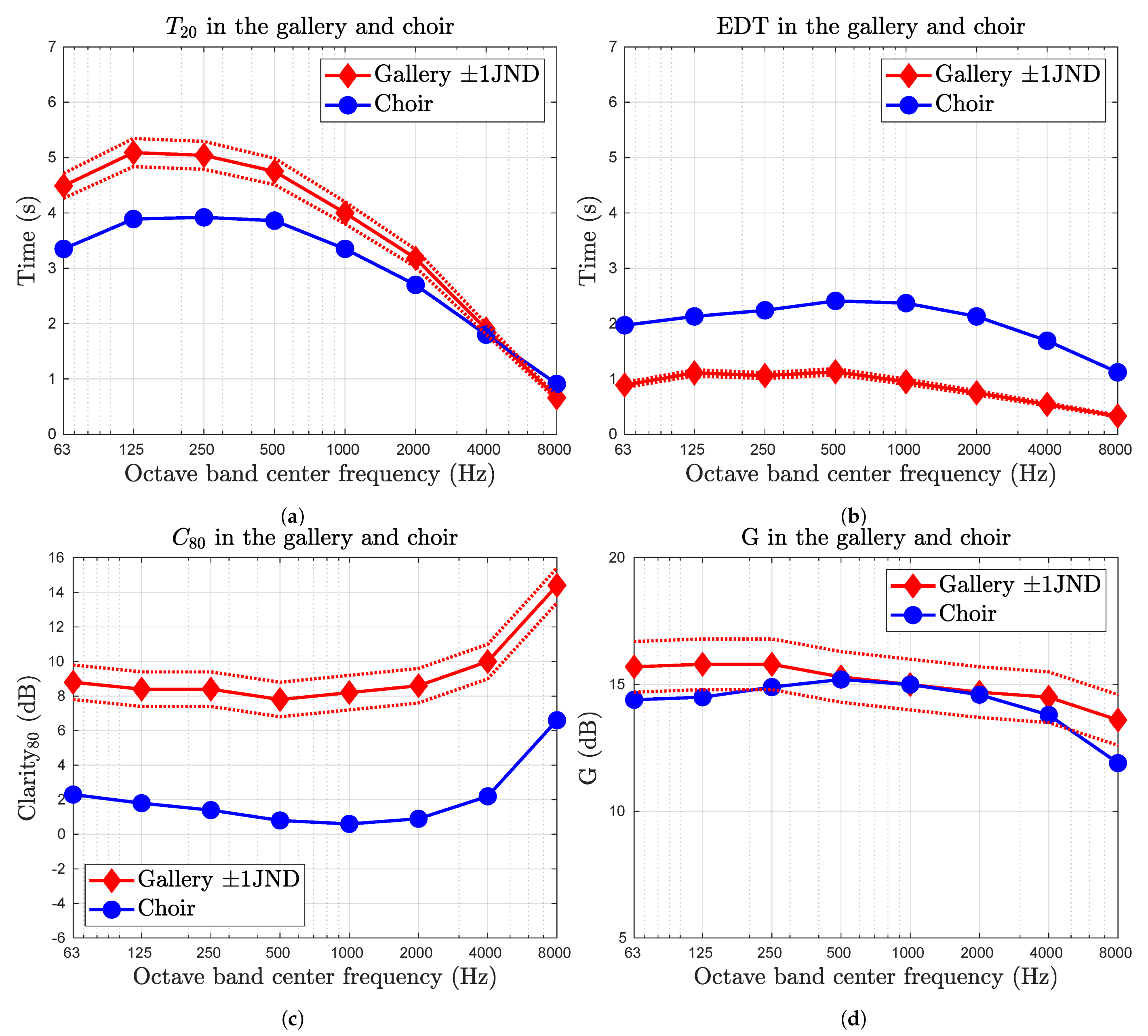
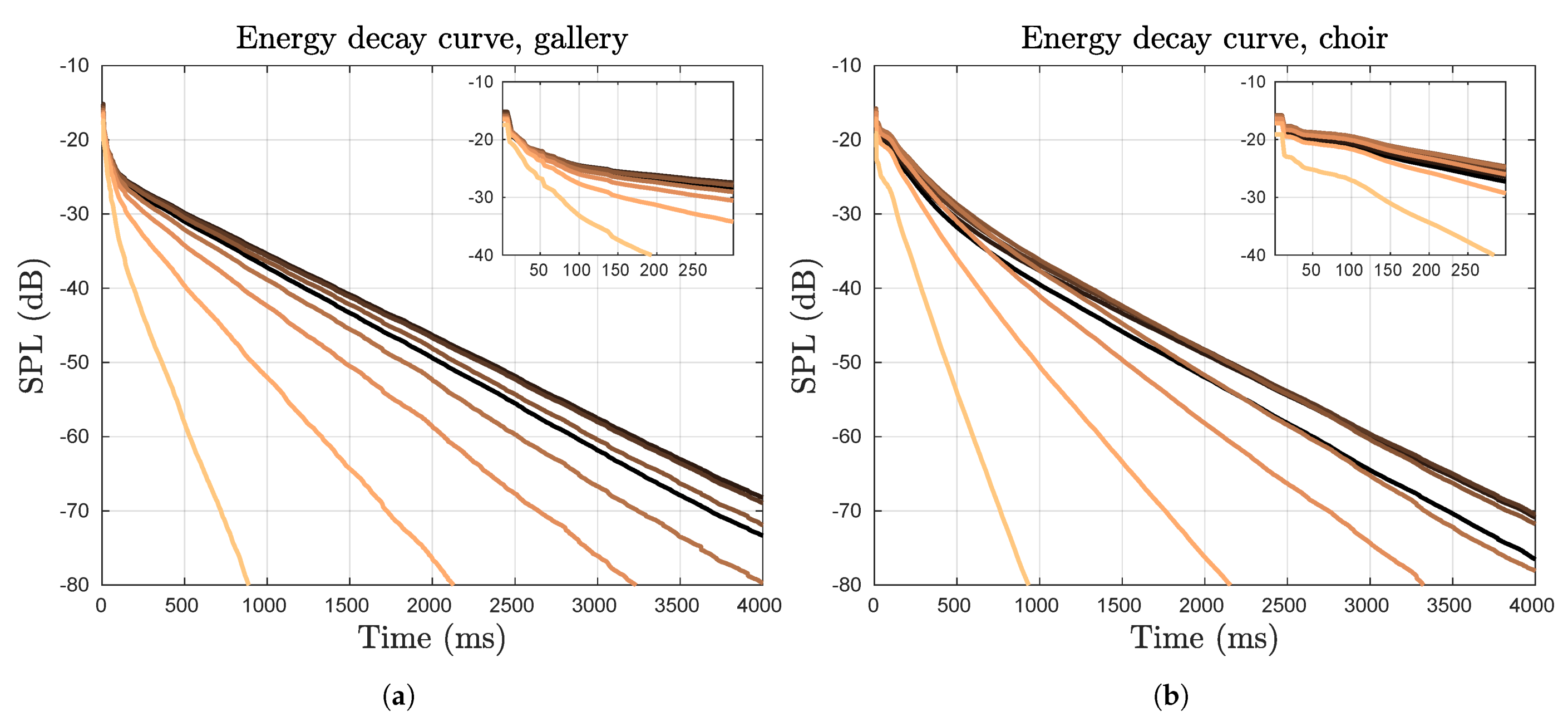
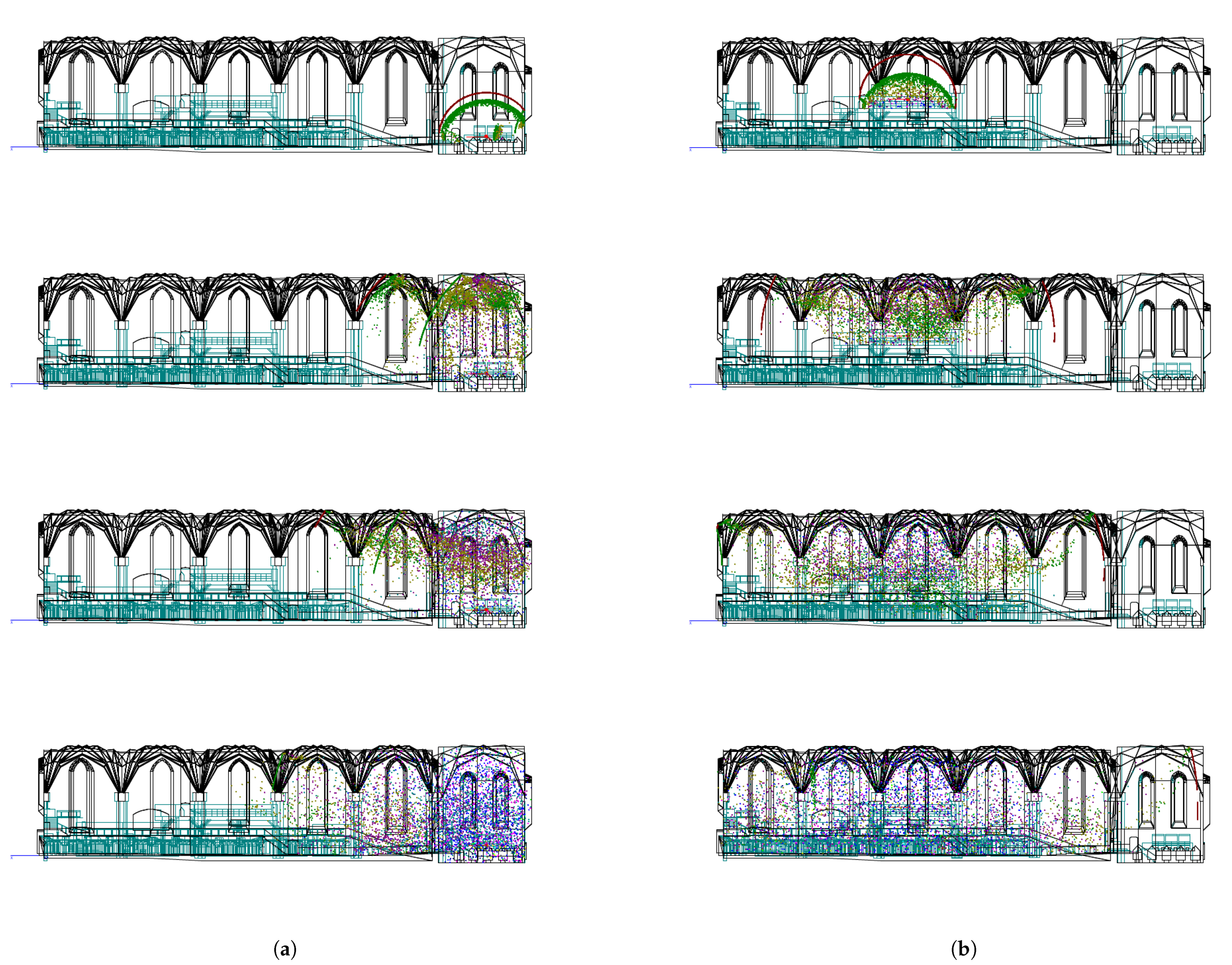
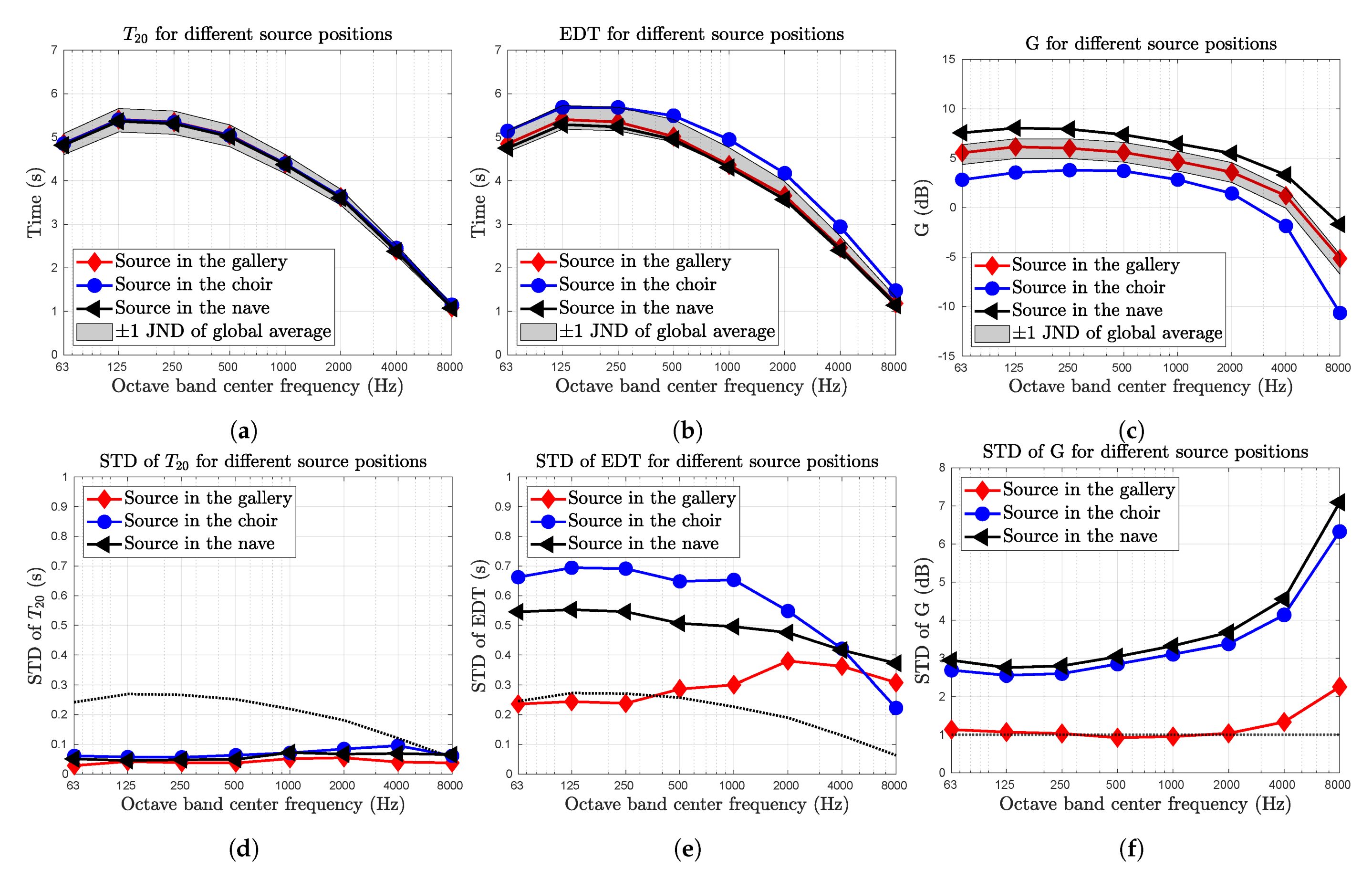

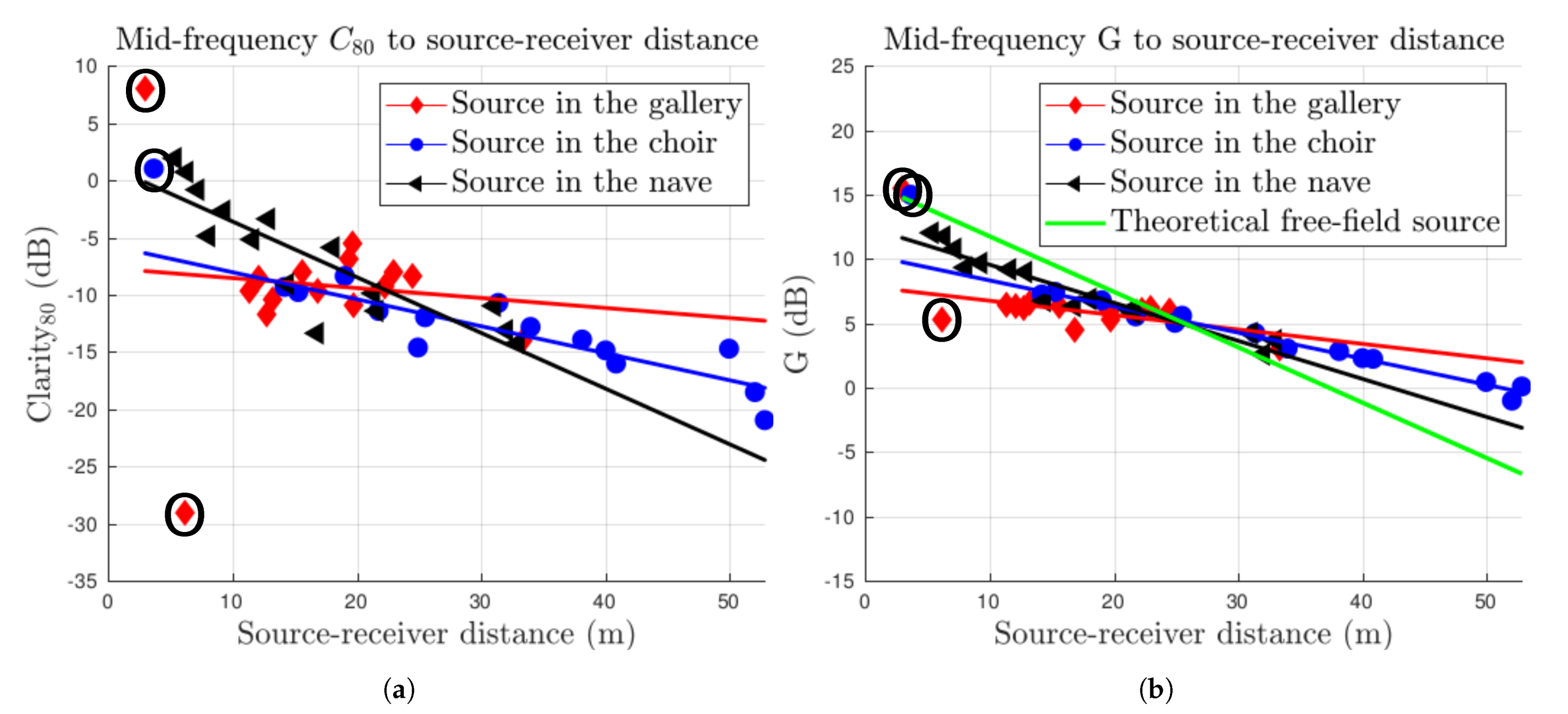
| Gallery | Choir | Nave | |||||||
|---|---|---|---|---|---|---|---|---|---|
| Empty | Sext | Full | Empty | Sext | Full | Empty | Sext | Full | |
| (s) | 5.17 | 4.90 | 4.00 | 4.06 | 3.89 | 3.26 | 5.37 | 5.19 | 4.36 |
| EDT (s) | 1.21 | 1.10 | 0.62 | 2.41 | 2.33 | 2.21 | 5.47 | 5.29 | 4.55 |
| (dB) | 8 | 8 | 10 | 1 | 1 | 1 | −10 | −10 | −10 |
| G (dB) | 16 | 16 | 15 | 15 | 15 | 15 | 6 | 6 | 4 |
| Church | Volume (m) | (s) |
|---|---|---|
| Swedish church, current configuration | 29,000 | 7.79 |
| Swedish church, historical configuration | 29,000 | 5.15 |
| Church of our Lady, Krakow, Poland | 9500 | 6.5 |
| Church of St Thomas, Lipsk, Germany | 18,000 | 4.05 |
| Marien Church, Lübeck, Germany | 100,000 | 5.50 |
Publisher’s Note: MDPI stays neutral with regard to jurisdictional claims in published maps and institutional affiliations. |
© 2021 by the authors. Licensee MDPI, Basel, Switzerland. This article is an open access article distributed under the terms and conditions of the Creative Commons Attribution (CC BY) license (http://creativecommons.org/licenses/by/4.0/).
Share and Cite
Autio, H.; Barbagallo, M.; Ask, C.; Bard Hagberg, D.; Lindqvist Sandgren, E.; Strinnholm Lagergren, K. Historically Based Room Acoustic Analysis and Auralization of a Church in the 1470s. Appl. Sci. 2021, 11, 1586. https://doi.org/10.3390/app11041586
Autio H, Barbagallo M, Ask C, Bard Hagberg D, Lindqvist Sandgren E, Strinnholm Lagergren K. Historically Based Room Acoustic Analysis and Auralization of a Church in the 1470s. Applied Sciences. 2021; 11(4):1586. https://doi.org/10.3390/app11041586
Chicago/Turabian StyleAutio, Hanna, Mathias Barbagallo, Carolina Ask, Delphine Bard Hagberg, Eva Lindqvist Sandgren, and Karin Strinnholm Lagergren. 2021. "Historically Based Room Acoustic Analysis and Auralization of a Church in the 1470s" Applied Sciences 11, no. 4: 1586. https://doi.org/10.3390/app11041586
APA StyleAutio, H., Barbagallo, M., Ask, C., Bard Hagberg, D., Lindqvist Sandgren, E., & Strinnholm Lagergren, K. (2021). Historically Based Room Acoustic Analysis and Auralization of a Church in the 1470s. Applied Sciences, 11(4), 1586. https://doi.org/10.3390/app11041586







